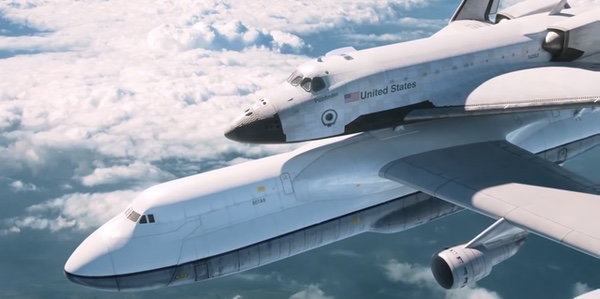Higher burning: The Air Launched Sortie Vehicle of the 1980sby Dwayne A. Day
|
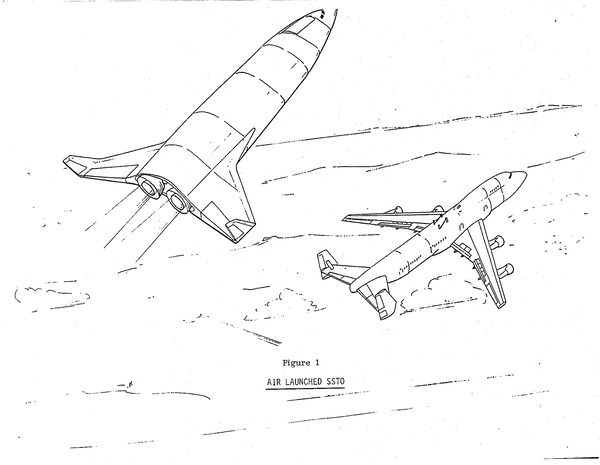 An early concept of the Space Sortie System without an external tank. This was supposed to provide quicker, and hopefully cheaper, launch of satellites than existing expendable rockets. One option, quickly discarded, was to use fluorine fuel. Studies starting in 1981 all included an external tank. (credit: US Air Force) |
Early origins of the ALSV
In late 1980, Don Hart, the head of the Air Force Rocket Propulsion Laboratory, outlined what was described as “an Air Force Sortie Space System” in a seven-page overview document. According to Dana Andrews, who later worked on the concept, Hart was concerned about the Air Force’s lack of responsive launch capability at the time. The Space Sortie System had three major parts: a launch platform, drop tanks, and a space vehicle. General Dynamics performed a basic assessment of the concept for the Air Force.
| This would be no ordinary 747. As jumbo jets go, it would have been a real hot rod. |
The launch platform was defined as a 747 that not only carried the space vehicle and drop tanks on its back, but also had liquid oxygen and liquid hydrogen storage tanks inside its fuselage. The tanks would be low boil-off dewars and the propellants would be pumped into the drop tanks just before separation of the vehicle and drop tanks.
This would be no ordinary 747. Not only would it have the internal tanks, but the hydrogen would also be pumped into afterburners on the 747’s large turbofan engines, providing up to 400 percent thrust augmentation. The 747 would fly a zoom parabola, with vehicle separation at 15,200–16,800 meters (50,000–55,000 feet) altitude. As jumbo jets go, it would have been a real hot rod.
The space vehicle would have two attached drop tanks based upon design, materials, tooling, and fabrication techniques for the Atlas launch vehicle. The tanks would be covered with the Space Shuttle’s spray-on insulation if necessary. The tanks would form an aerodynamically-shaped nose for a lifting ascent trajectory and be released from the space vehicle shortly before it reached orbit, to burn up on reentry. If necessary, they would be explosively blown into pieces. Unlike more traditional launch vehicles but like the Space Shuttle, each tank would have three inner tanks, with hydrogen in the front, oxygen in the middle, and hydrogen at the rear to control the center of gravity for a lifting ascent. Overall, the vehicle would be approximately 10.7 meters (35 feet) wide and 15.2 meters (50 feet) long.
The space vehicle would be reusable, making a runway landing after return from orbit. The vehicle’s shape would be derived from several flown or heavily-studied lifting body type vehicles such as the FDL-5, FDL-8, or X-24C. The vehicle would be powered by ten modified RL10 engines arranged in a 2 x 5 array. The turbomachinery and injector would be the same as the standard RL10, but the thrust chamber would be slightly longer, the expansion ratio slightly less, and there would be upper and lower expansion plates for better performance in vacuum. The backside of the expansion plates would also provide vehicle pitch control. During reentry, the plates would close completely, forming a boattail over the rear of the vehicle.
The vehicle itself would have a large crossrange, the ability to come down a significant distance from its orbital track. It could be piloted, but could probably carry no more than one person. The 747’s payload capability dictated the gross weight of the space vehicle and its drop tanks of no more than 100,000 kilograms (220,000 pounds).
As Don Hart explained it, the spacecraft could fly several kinds of missions. The basic mission would be to fly to low Earth orbit, stay there for the mission, possibly leaving a small payload in orbit, and then return to a runway landing. Another mission could involve delivering a medium-weight payload to low Earth orbit by releasing the payload at vehicle apogee and immediately returning to Earth. A mission described as “low altitude penetration of target area” would involve flying a shallow trajectory, skipping into the target area, and then reigniting the engines to power out and land. Finally, there was a maximum weight payload to low Earth orbit mission. This would not involve the space vehicle itself, only a cargo carrier and the ten RL10 rocket engines that would fly into orbit and would not be returned, although they could be retrieved by a Space Shuttle at a later date.
Hart also noted that another option would involve a very different vehicle sized to fit inside the Space Shuttle payload bay. Three shuttle flights would bring up the vehicle and separate fueled drop tanks. The vehicle would be assembled in orbit and could fly up to geosynchronous or another high energy orbit. After the mission it would return directly to a runway landing.
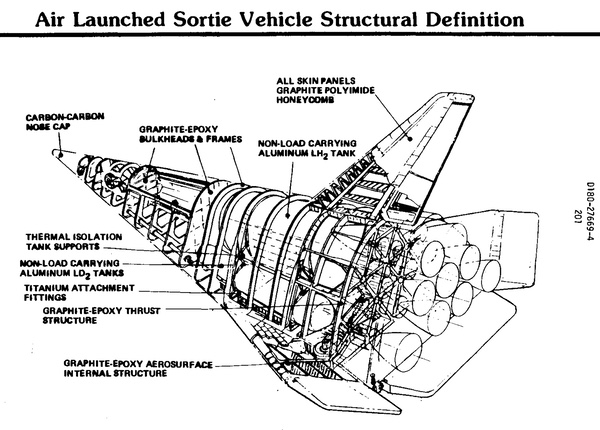 The Pratt & Whitney Air Launched Sortie Vehicle concept was studied starting in 1981. An initial configuration had ten RL10 engines mounted in a rectangle. This was changed to nine uprated RL10s in this configuration. Boeing was a sub-contractor for this design. Later, Boeing would develop its own version. (credit: US Air Force) |
According to Hart, a major goal for the Space Sortie System was rapid response. The aircraft and spacecraft could be supported from any Air Force base as long as there was an available supply of liquid hydrogen and oxygen. The vehicle could stand at “alert status,” with propellants inside the launch aircraft. It could take off on warning and fly to any azimuth because it would not produce debris. The goal would be to enable flyover of any point on Earth within 75 minutes, including 747 taxi, takeoff, and climbout. It could fly by any low Earth orbit satellite or space station within 75 minutes and rendezvous with any satellite or station within five hours. As Dana Andrews later explained in his book Chasing the Dream, one of the benefits of the ability to store hydrogen and oxygen inside the aircraft for long periods was that the plane could be deployed to remote airfields.
The vehicle would not only be reusable, but would have rapid turnaround of hours, not days. “All phases of sortie are under Air Force control. All ground operations by Air Force crews at Air Force bases,” Hart wrote. Nobody would have to worry about working with NASA.
| It is unclear what prompted the Air Force Rocket Propulsion Laboratory to propose such a vehicle or what kinds of missions could it fly. The small payload and at most single crewman limited what it could do. |
According to Hart, there were few technological risks and he outlined various aspects of the technology that already existed. The ability of a 747 to carry a piggyback payload had already been demonstrated by the shuttle program. An afterburner modification for the 747’s engines was already available and would not require changes to the fan, compressor, burners, or turbine. The drop tanks would be based on the Atlas tooling and fabrication techniques. The RL10 rocket engine had a long history and there was data on how it operated in multiple engine configurations. The “lifting ascent trajectory” had already been “examined in other programs,” according to Hart. The one unknown that he identified was whether or not the drop tanks would burn up entirely. That would require further study.
However, despite the optimistic assessment of the technology maturity, Hart’s document overlooked several important related issues. What kind of thermal protection would the vehicle use? Although the Space Shuttle had pioneered a new thermal protection system, would it be applicable to a differently-shaped vehicle? What kind of structure would the spacecraft use? Would separating a large vehicle from a 747 at high altitude pose any problems? And finally, would pumping large amounts of liquid oxygen and liquid hydrogen from one vehicle to another while in flight be problematic?
The system would be a near-term solution whose existence “would certainly challenge USSR strategic defense structure,” Hart wrote. It was “not a traditional launch vehicle, nor a traditional satellite, nor a traditional aircraft,” and therefore “non-traditional thinking” was needed to determine what it could accomplish.
It is unclear what prompted the Air Force Rocket Propulsion Laboratory to propose such a vehicle or what kinds of missions could it fly. The small payload and at most single crewman limited what it could do. The Space Sortie System apparently was more of a concept for a rapid response launch vehicle than the potential answer to a clear—or even vague—military requirement. In some ways it resembled earlier Air Force concepts of piloted space vehicles such as the late 1950s BOMI (“bomber missile”) and the early 1960s X-20 Dyna-Soar. Those concepts never found clear justifications for their costs and were not developed to flight vehicles.
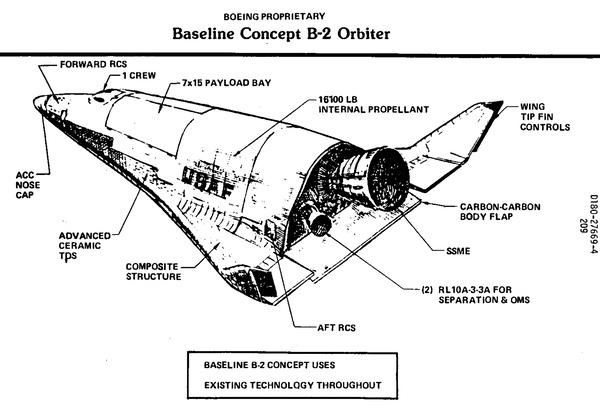 Boeing’s Trans-Atmospheric Vehicle B-2 ALSV concept was studied from 1982 to 1983. Boeing vastly reduced the number of engines and changed the shape of the vehicle. The two outboard RL10 engines would have been fired while the vehicle was still connected to the 747. (credit: US Air Force) |
Evolving the ALSV
If this December 1980 document was intended to prompt aerospace contractors into action, it certainly had an effect. Within a short period of time, several contractors began considering such a spacecraft, including Space Shuttle contractor Rockwell International, engine manufacturer Pratt & Whitney, and Boeing.
In November 1981, AFRPL awarded a contract to rocket engine manufacturer Pratt & Whitney, who completed a study by August of 1982 and went public with it soon after. A story about the concept appeared in Aviation Week & Space Technology, and other articles appeared in other publications. Dramatic artwork produced by Boeing showing the spacecraft separating from its 747 mothership appeared in numerous publications, even as obscure as the Buffalo Evening News. The artwork was usually accompanied by captions referring to this as “the Air Force’s new spaceship.”
| The United States at that time had only two LOX/H2 rocket engines, the powerful Space Shuttle Main Engine (SSME) and the RL10. The SSME was too large to provide a multi-engine capability in event of an engine shutdown. |
According to two Pratt & Whitney engineers, Jerry Cuffe and Charles “Chuck” Limerick, who wrote about their study in 1983, normally the Air Force would hire a prime contractor to perform a study, and that prime contractor would then hire subcontractors—like rocket engine companies—to perform specific portions of the work. It was unusual for Pratt & Whitney to be hired as the prime, with Boeing as a subcontractor. But the Air Force took this path because the engine was the primary driver in the design—and also presumably because the Air Force Rocket Propulsion Laboratory was used to dealing with rocket companies. Boeing was hired as a subcontractor because the study dictated use of a 747 and “it was also essential that the propulsion system performance sensitivities and requirements imposed by the 747 aircraft capability, vehicle weight, and mission trajectory were realistic,” Cuffe and Limerick wrote. Vince Caluori was the Boeing program manager, and Dana Andrews was Boeing’s technical leader for the project. Other Boeing engineers who worked on it were Jim Jenkins, who served as systems engineer; Bob Conrad, who was the weights engineer; and Harrison Whippo, the propulsion specialist. In addition to determining if a 747 could carry the weight and how it would be modified, part of Boeing’s task included evaluating if a 747 could be flown in the manner required for deploying the spacecraft.
Cuffe and Limerick explained that normally, to maximize performance, they would have designed a new engine from scratch. However, one of the primary Air Force requirements was to field the Space Sortie System within the decade. With limited time, “a modified, existing engine was, therefore essential,” they explained. Other modified and existing systems would also be used when possible.
Cuffe and Limerick also explained that because the delta-v requirement for reaching orbit was so high, the only viable propellant combination for the mission was liquid hydrogen and liquid oxygen. The United States at that time had only two LOX/H2 rocket engines, the powerful Space Shuttle Main Engine (SSME) and the RL10. The SSME was too large to provide a multi-engine capability in event of an engine shutdown. It also lacked the ability to throttle down its thrust substantially. The ability to throttle down is important because as a rocket burns up fuel, it gets lighter and therefore it accelerates more. If the engine thrust is not reduced, this can overstress the structure and it will break at high speed.
At the time of their study, the standard engine in production was the RL10A-3-3A, but this engine was not suitable for the mission. With several upgrades, such as increasing the throat diameter of the engine and changing the contour of the nozzle, the RL10 engine’s thrust could be more than doubled from 73,400 newtons (16,500 pounds) in vacuum to 153,500 newtons (34,500 pounds) of thrust. It would only operate at this high level for a short period of time after launch before throttling back to 133,000 newtons (30,000 pounds) of thrust. In contrast, a version of the RL10 used three decades later generated 110,000 newtons (24,750 pounds) of thrust.
The basic Sortie Vehicle would use nine of these “34.5K” RL10 engines in its tail for power. The Sortie Vehicle engines would operate for approximately 160 seconds after launch at full power, then throttle down to their 30K cruise thrust setting. They would stay at this setting until a further throttle down was required to limit the acceleration loads on the vehicle. Eventually, the vehicle would start shutting down engines, jettison its external tank, and finally only three engines would be used to push it the last little bit into orbit.
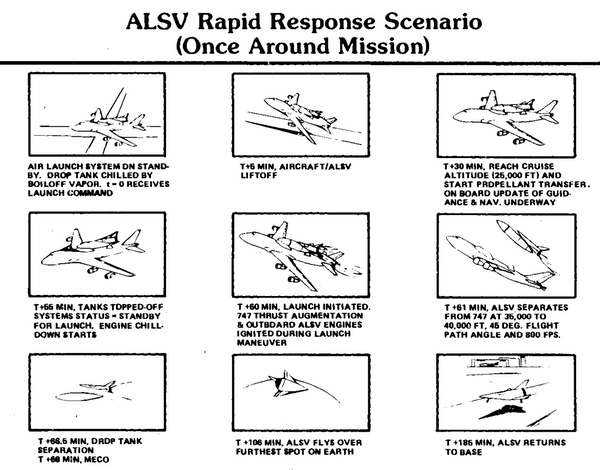 Boeing’s concept for the ALSV “once-around” mission that would have had the vehicle landing without entering orbit. The requirement for this mission was never explained—and was probably never actually defined—but it could be interpreted as either single orbit reconnaissance, or launch of a weapon. (credit: US Air Force) |
Spacecraft configuration
Pratt & Whitney’s study originally started off with a cluster of 30K engines consisting of two rows of five RL10s, contained in a rectangular shroud that was intended to improve their performance at high altitude. As a rocket gets higher, there is less air pressure, which allows the exhaust plume to spread out. This lowers performance, so rocket designers try to contain the plume as much as possible as the air pressure gets lower and lower.
But the engineers quickly realized that as engines were turned off to prevent exceeding the acceleration limits, this rectangular shroud would be inefficient; as an engine shut down, the other engines would be farther away from the edge of the shroud and so their exhaust would spread out. The shroud at the back of the vehicle would not be fully filled when less than four engines were still firing. Another problem was that with the engines all packed in closely next to each other, they could not be gimbaled to provide vehicle control capability during ascent. This also produced a longer and wider vehicle than desirable because the spacecraft had to be triangular for reentry and landing.
Once the engineers determined that they could uprate the RL10 engine power to 34.5K, they could eliminate one of the ten engines and change the way they were mounted at the rear of the vehicle. Rather than putting the engines in two flat rows, they produced a configuration of seven engines mounted in a circle, with two engines outboard on either side. This made for a taller, shorter vehicle. It also meant that the engines in the circle could be shrouded, increasing their performance, and the two outboard engines could be gimbaled for attitude control.
| Although hydrogen afterburners for the 747 were possible, they did not already exist, and this would require a lengthy development program. Instead, they decided to select an existing rocket engine to mount to the 747. |
In this new configuration, the engineers initially looked at the possibility of a cylindrical shroud surrounding the engines in a circle. The shroud would extend as the vehicle gained altitude, operating at two positions during the flight before being jettisoned. But the shroud had poor performance at low altitude, and as a next step the engineers looked at a reusable four-position extendible/retractable shroud. Both the disposable and reusable shrouds would allow for the two outboard engines to be pressure-fed with a low thrust capability.
The reusable shroud design improved performance, but not by much. At best it provided a net payload increase of 135 kilograms (300 pounds). But this came at the cost of added complexity, operational and maintenance problems, and increased difficulty of system testing during development. The engineers determined that it was a better idea to simply leave the shroud off and accept slightly lower performance. This also allowed the outboard engines to delete the pressure-fed configuration and use the same design as the other seven engines.
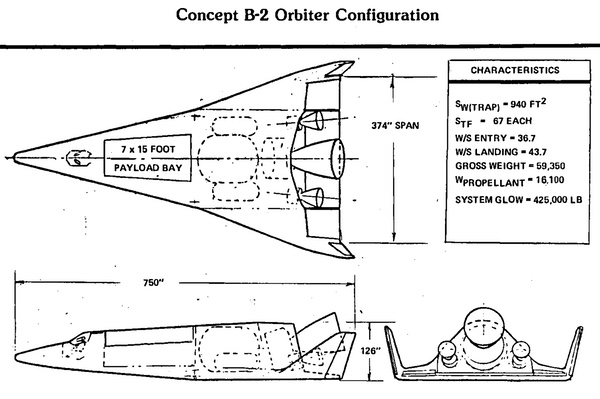 Interior arrangement of the Trans-Atmospheric Vehicle B-2 ALSV concept studied by Boeing in 1983. The craft would have had an integral cockpit, unlike an earlier design. (credit: US Air Force) |
The hot rod 747
The 747 is a big and powerful aircraft, but not when it has another massive aircraft sitting on its back. With the Sortie Vehicle attached it could only reach a maximum altitude of 7,600 meters (25,000 feet). But the amount of mass that the space vehicle could inject into orbit depended heavily upon the altitude at which it separated from the 747 and the flight path angle. Also, separating the two vehicles at less than 9,100 meters (30,000 feet) would result in the Sortie Vehicle slowing down due to air drag, which would push propellants in their tanks away from the rocket engine inlets, making it hard to start them.
According to Limerick and Cuffe, although hydrogen afterburners for the 747 were possible, they did not already exist, and this would require a lengthy development program. Instead, they decided to select an existing rocket engine to mount to the 747.
As Dana Andrews remembered it, Boeing’s engineers first proposed using the Space Shuttle Main Engine “as a major performance improvement” to the craft. The SSME has over 2.18 million newtons (490,000 pounds) of thrust in vacuum. It’s a powerful thoroughbred of an engine.
But Pratt & Whitney’s engineers countered that the SSME was not ideal for the job. Instead, they opted in favor of a cluster of seven RL10s at the rear of the fuselage. They would be identical to the ones used in the Sortie Vehicle but would have different nozzles. The RL10 required less than a minute of preconditioning prior to start, compared to approximately 40 minutes for the SSME. The RL10 cluster provided engine-out capability, reduced initial and operating costs, and “ripple start capability” that reduced the tank pressure requirements for starting compared to the SSME. Pratt & Whitney even posed the possibility of using the RL10s during aircraft takeoff to get off the ground, just like the “Jet-Assisted Take-Off,” or “JATO” rockets used to launch heavy aircraft in the 1940s and 1950s.
The aft end of the fuselage proved to be a good location for the rocket engines. The rear of the 747’s passenger cabin contains the end of the pressurized compartment of the plane. The pressure in the tank pushes against the back of the tank, and the rocket engines could be mounted on the other side of the tank and would push forward against the air pressure inside the tank pushing back. It was a structurally sound design.
The launch aircraft would be a modified 747-200F, the freighter version of the jumbo jet. A single large cylindrical 19,500-kilogram (43,000-pound) liquid hydrogen dewar would fill most of the aircraft interior. Two smaller cylindrical dewars carrying 114,000 kilograms (250,000 pounds) of liquid oxygen would be mounted over the wing base of the aircraft. The entire craft was supposed to be capable of standing alert on a runway.
Total weight of the 747 and its Sortie Vehicle and tank at takeoff would be 390,000 kilograms (860,000 pounds), including 128,000 kilograms (283,000 pounds) of cryogenic propellants and 72,500 kilograms (160,000 pounds) of fuel for the 747’s turbofan engines. The system could place 10,500 kilograms (23,150 pounds) into a nominal 185-kilometer (100-nautical-mile) polar orbit, enabling approximately 1,360 kilograms (3,000 pounds) of “discretionary mission equipment” to be carried “on a round trip mission.”
| What has not been public until now is that by 1983, the Air Force had initiated a “Trans-Atmospheric Vehicles” (TAV) initiative that further refined the ALSV. |
The Sortie Vehicle’s single drop tank would have a diameter of 4.32 meters (170 inches) and a length of 24.4 meters (80 feet). It would require some thermal protection due to heating caused during ascent. Because the tank would be so lightweight, it would also require support by a cradle that fully distributed the load. The tank would be jettisoned as the vehicle reached 109,000 meters (357,000 feet). Limerick and Cuffe acknowledged that they had not evaluated all of the possible options for the craft. For instance, one option, which was mentioned in the original December 1980 document that outlined the Space Sortie System, was to use a “lifting ascent” whereby the vehicle generated lift as it flew forward so that the engines did not do all of the work. Such a design would not have the large bulbous tank that they projected, but presumably a more wedge-shaped design capable of generating some lift of its own.
Pratt & Whitney—an engine company, not a spacecraft company—did not devote much attention to the actual design of the Sortie Vehicle and determined the best shape primarily by what would best support the engines. Rockwell, which was conducting its own study, investigated both a wedge-shaped lifting-body shape derived from the FDL-5 as well as something that looked more like a stunted Space Shuttle design. In comparison, the Pratt & Whitney design was a wedge-shaped pyramid, approximately 15.8 meters (52 feet) long and 9.1 meters (30 feet) wide and weighing about 9,100 kilograms (20,000 pounds). It had tall, angled sides, and small winglets and a single tail. The “discretionary equipment bay” would be approximately 2.5 meters (100 inches) long and increase from approximately 1.3 meters (53 inches) in diameter at the front to 1.6 meters (64 inches) in diameter at the rear. This was big enough to carry an astronaut (after all, the Mercury spacecraft was only a little larger than the ALSV payload bay).
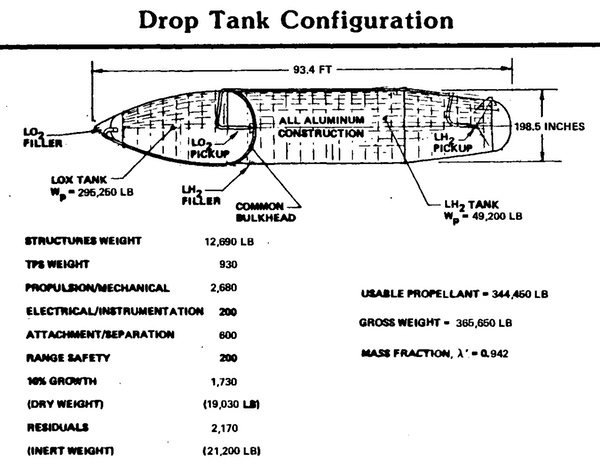 The external tank for the 1983 Boeing concept. This disposable tank would have been expensive, making the concept less viable than Air Force use of the Space Shuttle. (credit: US Air Force) |
Boeing’s Refined ALSV/Trans-Atmospheric Vehicle
What has not been public until now is that by 1983, the Air Force had initiated a “Trans-Atmospheric Vehicles” (TAV) initiative that further refined the ALSV. This period is confusing because the Air Force was engaged in several overlapping studies including the Advanced Manned Spaceflight Capability (AMSC) Study that started in 1981. Several contractors, including Rockwell and Boeing, were apparently studying similar vehicle concepts both for the AMSC and TAV work, possibly using some of their own internal research and development funding to keep the studies alive between Air Force contracts.
Boeing conducted three TAV studies by May 1983, which the company labeled concepts B-1, B-2, and B-3 for ease of reference. Boeing’s concepts involved vehicles that could place 2,268 to 13,608 kilograms (5,000 to 30,000 pounds) of payload into low Earth orbit using horizontal takeoff vehicles. The B-1 concept was a “Two-Stage Horizontal Take-Off Launch System” that used a large, V-shaped mothership equipped with eight jet engines and a single Space Shuttle Main Engine (SSME) to drop a SSME-powered orbital vehicle at very high altitude to ascend to orbit with a substantial payload. Boeing’s B-2 concept was derived from the Air Launched Sortie System originally studied by Pratt & Whitney with Boeing as the subcontractor. The B-3 concept was designated the “Reusable Aerodynamic Space Vehicle System” and equipped with two Space Shuttle Main Engines and launched on a rocket-powered wheeled sled that was also equipped with two SSMEs. The Air Force required Boeing to submit the three TAV concepts to Batelle Columbus Laboratories for evaluation. Battelle’s evaluation took place between May and December 1983, when Batelle issued its final report to the Air Force. Rockwell also studied a rocket-sled launch concept, its own version of the ALSV, and another concept that involved dropping a Sortie Vehicle design attached to a rocket out of the rear of a C-5 Galaxy and igniting the rocket during freefall.
Boeing’s three concepts were crewed, and “were conceived with military operational readiness as a prime overall requirement,” according to the Batelle report. “Each concept achieves survivability by rapid dispersion airfield to airfield.”
In the Batelle report, “ALSV,” “TAV,” and “B-2 Orbiter” were used interchangeably, but Boeing had further refined the partially-reusable vehicle, and it differed from the earlier Pratt & Whitney-led ALSV in several respects, notably the inclusion of a crew cabin, fewer engines, and a refined, more rounded and less angular vehicle shape. Boeing had also greatly simplified the launcher aircraft, eliminating any need for hydrogen-augmented jet engines, or the earlier concept’s most striking feature: the Space Shuttle Main Engine in the 747’s tail. Instead, the orbiting vehicle would fire its two outboard rocket engines while still attached to the 747 to provide a last bit of acceleration required before vehicle separation.
| “The Air Launched Sortie approach trades early low-cost, low-risk development against higher operating costs,” the report stated. |
Compared to the other two designs, the ALSV/TAV approach was intended to require the least new development, particularly by using a 747 as a launch aircraft compared to the Two-Stage Horizontal Take-Off Launch System, which required an all-new rocket-powered mothership aircraft. The rocket-sled launched RASV required not only the rocket sled, but also heavily-modified SSMEs with deployable exhaust shrouds to deal with the different atmospheric pressures as the vehicle went from the ground to outer space.
The revised ALSV/TAV would use existing engines, the SSME and RL10’s. Although the 747 had been simplified compared to the previous concept, it would not have been a stock 747, but a “growth derivative” 747 with a larger, 7000-square foot wing. Such a wing had already been studied by the company for an upgraded 747, but to carry the ALSV/TAV, it would also require additional strengthening. Boeing claimed that design and tooling costs for the new wing could be offset by freighter or commercial production, although that required commercial customers in addition to the Air Force.
“The Air Launched Sortie approach trades early low-cost, low-risk development against higher operating costs,” the report stated. But according to the Batelle evaluation, the key question was the breakeven flights per vehicle.
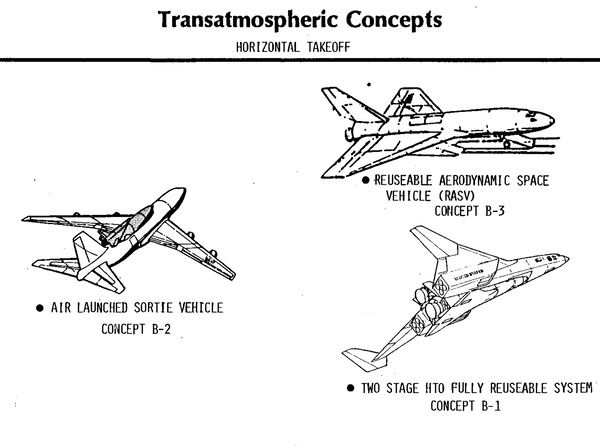 The three Trans-Atmospheric Vehicle concepts studied by Boeing in the 1983 timeframe. The ALSV would have had the lowest development cost and shortest development time of the three vehicles, but was predicted to have higher operational costs. All three vehicles seemed to be a solution in search of a clear space launch requirement, and appeared to have been more inspired by concepts of rapid-response strategic bombers than actual space operations. (credit: US Air Force) |
The 747 would contain large dewars in its fuselage for long-term storage of liquid hydrogen and liquid oxygen. The ALSV/TAV’s fuel tank would be empty upon liftoff, but once at its cruising altitude, the 747 could pump the hydrogen and oxygen into the external tank and the orbiter’s internal tanks in preparation for launch.
The orbital vehicle would only operate for one or two orbits, minimizing losses of cryogenic propellant. The internal propellant could be used for the de-orbit burn or other propulsive maneuvers.
The ALSV/TAV orbiter eliminated the nine heavily-modified RL10 engines of the earlier studies in favor of a single SSME and a pair of “standard” RL10s. Increased thrust-weight eliminated need for rocket augmentation of the 747.
The operational plan was to have the vehicle on the ground in “ready alert” condition with fuel in dewars, remaining in readiness condition for up to 30 days. It could be off the ground in five minutes, “therefore meeting the Strategic Air Command bomber alert” requirement. It would climb to cruising altitude in 30 minutes. If the launch was approved, the 747 could then transfer propellant into the external tank and into the Sortie Vehicle. “The mated vehicles perform a pull-up maneuver using the 747 engines and the outboard engines on the Sortie vehicle,” the report stated. After about one minute the 747 would go through a pushover maneuver to generate negative g’s and the vehicles would separate. After separation, the Sortie Vehicle would go up to full thrust and ascend into orbit.
The original ALSV concept was for an optionally-crewed spacecraft. Boeing’s revised vehicle was sized for two crew members, but would normally carry only one. The vehicle could also be flown autonomously, with no crew aboard. The payload bay would be 2.1 by 4.6 meters (7 by 15 feet). It could carry 2,268 kilograms (5,000 pounds) into near-orbit in a once-around polar capability, meaning that the vehicle landed after a single orbit, or 3,629 kilograms (8,000 pounds) in a 296-kilometer (160-nautical-mile) orbit when launched into a 28.5 degree inclination.
The 747 would be equipped with a V-tail to enable use of orbiter thrust to obtain a higher flight path angle and altitude—the engines would burn a conventional tail. According to Boeing, the 747 could fly up to two missions per day. But an impediment to achieving fast turnarounds was integrating the payload into the orbiter. Experience with the Space Shuttle had demonstrated that this required a lot of time unless both payload and orbiter were equipped with standard mounting interfaces that tended to be bulky and heavy. Boeing’s recommendation was to purchase more orbiters and integrate the payloads and drop tanks in advance.
The vehicle would cost more than fully reusable concepts because the tank would be discarded. But the proposers suggested that with high enough flight rates, the ALSV could be more cost effective.
| It was never clear what the ALSV could do that was vital to national security. |
The development time was estimated at seven and a half years from the start of concept definition to hardware delivery, with an estimated $4.2 billion development cost. The study suggested that 10 carrier aircraft and 50 orbiter vehicles and support equipment at 10 airbases would cost $11.4 billion. In comparison, the B-1 and B-3 concepts had significantly higher development costs and longer times to becoming operational—the two-stage concept would take nearly 12 years to become operational, for example. However, the other two vehicles did offer significantly larger payloads, up to six times the mass of the ALSV/TAV payload.
Boeing’s ALSV/TAV team considered several possible growth versions of their design, but none offered significant performance increases. The baseline design was therefore the best option.
The study also indicated that the Air Force could develop its own Space Transportation System based on the ALSV concept. This could include a ground launch using shuttle-derived hardware such as the external tank and solid rocket boosters along with an ALSV, and an unmanned launch vehicle that would also launch off the back of a 747.
Batelle did not recommend any of Boeing’s three TAV vehicles—that was not the purpose of their evaluation—but the company did provide a set of criteria the Air Force could use to evaluate their performance. Batelle also made recommendations about a future Phase II trans-atmospheric vehicle program and options for future rocket-powered aircraft based upon the two-stage (B-1) concept that clearly required the most in the way of new development.
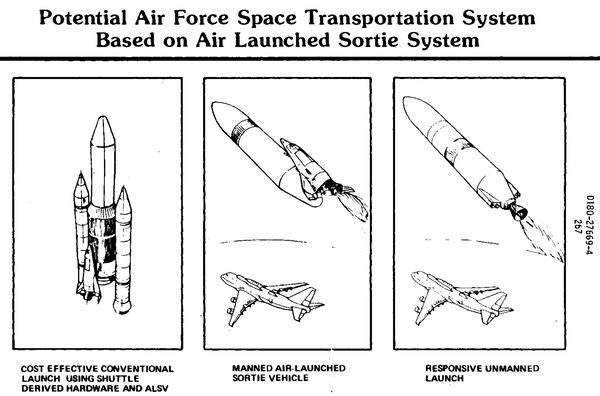 Boeing engineers also suggested that the B-2 ALSV concept could form the core of a space transportation system for the Air Force. (credit: US Air Force) |
Conclusion
Although both the 747 and the spacecraft were reusable, like the Space Shuttle the ALSV was only partially reusable. According to Dana Andrews, although the studies showed that the vehicle could be built, the Air Force was thwarted by the cost of the external tank. Andrews said that the tank alone was estimated to cost $15 million, although in Chasing the Dream he noted that they used a NASA cost-estimation tool that probably over-inflated the cost. It was more than the Air Force was willing to pay for the ability to place only 2,268 kilograms of cargo into orbit. Furthermore, at that time the Space Shuttle was subsidized by NASA, and Andrews remembered that the price for putting a payload on the more-capable shuttle was less than the cost of an ALSV tank.
There was probably another obstacle as well: it was never clear what the ALSV could do that was vital to national security. In the early 1980s, it was still official US Air Force policy to retire its fleet of expendable launch vehicles like the Atlas and Delta and switch all remaining national security payloads to the Space Shuttle. It would not make sense to launch really small payloads aboard the shuttle, and so the ALSV could have provided that service. But there were no stated requirements for such a vehicle from the senior levels of the Air Force or the Pentagon.
The single-orbit requirement was also unusual—the stated requirement was for the vehicle to fly once around the Earth at “500,000 feet,” or 152 kilometers. It is not possible for a spacecraft to orbit at such a low altitude, and any payload it deployed would either have to boost itself into orbit, or would fall back to Earth. It is possible that the idea was to carry a quick-response reconnaissance payload. But the requirement was more akin to flying a bombing profile than operating a launch vehicle, and to an adversary the ALSV would have looked like a potential first-strike weapon.
| Over the next several years, the Air Force continued general studies into the possibility of a quick-reaction craft that could operate either at extremely high altitudes or possibly even in low orbit. But these did not proceed to development. |
That requirement and others, such as the ability to stand ready alert on an airfield, were more appropriate to air-breathing bombers such as B-52s. The ALSV and other TAV concepts appear to have been defined more by the airplane part of the Air Force than the space operations part of the Air Force, with a poor understanding of what satellites do and are used for. The actual payloads that needed or could use the capabilities established in the requirements were never defined. Early warning, communications, reconnaissance, meteorology and other satellite missions are not mentioned in the report, leaving the impression that those who established the requirements didn’t understand those missions and also assumed that satellites are not much different than munitions in terms of their ruggedness and ability to sit inside an aircraft unattended for long periods of time.
ALSV’s other attributes, such as its ability to launch from virtually anywhere in the world to any orbit, were not sufficiently attractive to keep the program going. Over the next several years, the Air Force continued general studies into the possibility of a quick-reaction craft that could operate either at extremely high altitudes or possibly even in low orbit. But these did not proceed to development. In 1988, the Soviet Union evaluated a “multipurpose aerospace system” known as MAKS that was clearly inspired by the ALSV concept. It would have launched off the top of a giant Antonov An-225 Mriya aircraft that had been developed to carry the Soviet Union’s Buran space shuttle.
The Pathfinder space shuttle in “For All Mankind” is a nuclear-powered dreamship, capable of flying all the way to the Moon and back, and apparently eventually destined for Mars. It is a science fiction vehicle that has to defy the laws of physics and common sense to work. But it has its roots in a very real, very plausible concept from 40 years ago. The Air Launched Sortie Vehicle never found a mission to justify its development, but its imaginary cousin now flies on television.
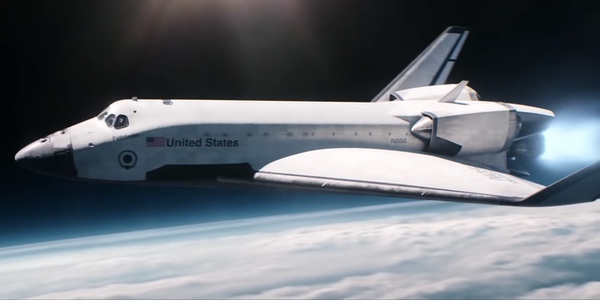 The Pathfinder space shuttle from the Apple TV+ series "For All Mankind." The spacecraft is not only air-launched, but nuclear powered. (credit: Apple TV+) |
Note: we are using a new commenting system, which may require you to create a new account.
